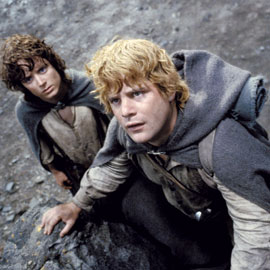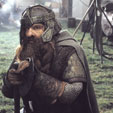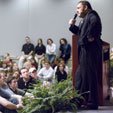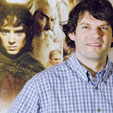| Beyond the Shire “Gimli
the Dwarf ” Joins a Fellowship of Students, Faculty and Staff
to Explore Tolkien’s Middle-Earth
On a Saturday morning in
January, Seattle Pacific University
Minister of Discipleship
Matthew Koenig watched as
young people clad in greenhooded
capes made their way
into Upper Gwinn Commons
to claim seats — several hours before the scheduled speaker even arrived at the
podium.

|
 |
What would draw students out of their residence halls on a weekend?
And in costume, no less? It was not just a movie star who drew
them, although his arrival would cause a stir on any campus. These
students were attracted by the same power that has provoked a 50-year
publishing phenomenon and, more recently, record-breaking box office
receipts. They were drawn by the power of the One Ring … or, more
accurately, the allure of J.R.R. Tolkien’s The Lord of the Rings.
Koenig first journeyed through Middleearth only recently. As so
many readers have experienced since the first publication of “the
book of the century” in 1953, he was challenged and captivated
by Tolkien’s imagination, voice and resonant Christian themes.
Moreover, he was inspired.
Koenig joined with Bryan Cole in the
Office of Student Programs to create The Lord of the Rings Film
and Lecture Event, a campus festival coinciding with the theatrical
run of the third film in director Peter Jackson’s adaptation of
the trilogy. On January 15 and 17, New Line Cinema’s “The Fellowship
of the Ring” and “The Two Towers” played on SPU screens. One of
the film’s beloved stars — Rhys-Davies (Gimli) — made a guest appearance.
Seminars hosted by faculty, staff and guests covered a variety
of perspectives on the saga. For a finale, Koenig arranged for
almost 100 students to attend a Saturday evening screening of “The
Return of the King” at Seattle’s famous Cinerama theater.
While
Koenig has not yet gone so far as to don hobbit garb like some
enthusiastic students, he does find Middle-earth to be a rewarding
context in which to consider the challenges of following Christ
into places unknown. The sacrificial departure of Frodo the hobbit
from his idyllic home in the Shire and the desperate quest he undertakes
to destroy the One Ring — Middle-earth’s weapon of mass destruction — suggest
the story of a savior who bore a cross in order to save the world.
Similarly, the tale of Aragorn, a man wrestling with the responsibility
of accepting his destiny as king, suggests to Koenig the way people
must wrestle with their own self-doubts in order to embrace God’s
call.
“I don’t want students to leave SPU thinking discipleship
is heavy, draining or unexciting,” Koenig explains. “The path of
discipleship is relentlessly demanding, but at the same time it
is invigorating and life-affirming.”
Many Readers, Many Interpretations
Koenig’s vision proved contagious. Tolkien experts and enthusiasts
from on and off campus volunteered to lead students in exploring
various corners of Middle-earth.
In a seminar titled “Notions of
Fellowship in The Lord of the Rings,” Residence Life Coordinator
Chuck Strawn focused on the heroes’ demonstrations of loyalty,
forgiveness, self-sacrifice, wisdomseeking, and willingness to
overcome prejudice and personal desires. “I think we are hungering
for this,” he said, “because we can’t find it in those whose lives
usually fill our television and movie screens.”
“We idealize freedom
without restraint, but we’re wrong to do so,” Associate Professor
of Philosophy Phillip Goggans told the audience in his session
titled “The Meaning of Life in The Lord of the Rings.” “It’s not
in our best interest to be absolutely free. We can never succeed
anyway, and we make ourselves miserable in the attempt. The characters
in The Lord of the Rings have a fixed purpose not subordinate to
their will. This is the truth about us and what we long to believe.”
Christie
Eppler, assistant professor of counselor education, explored the
resiliency of Frodo in her presentation, “To Journey On When All
Seems Lost.” Other seminar topics included “I Fear a Cage: Courage
and Calling for Women in The Lord of the Rings,” presented by Laurie
Wheeler, associate pastor of Seattle’s Church at the Center; and “Tragedy
and Triumph in The Lord of the Rings,” led by Gregory Wolfe, editor
of Image: A Journal of the Arts and Religion.
A Small Character
Played by a Big Name
For many, a visit from Rhys-Davies — who participated
in all three installments of Peter Jackson’s film trilogy as both
the temperamental, axe-wielding dwarf named Gimli and as the voice
of Treebeard — proved the highlight of the Seattle Pacific event.
As Gimli, this 60-year-old veteran of stage and screen was made
unrecognizable beneath layers of makeup and a bristling red moustache
and beard that required several hours of application daily. (Don’t
let the movies fool you: He’s actually taller than the actors who
played Gandalf, Aragorn and Legolas.) Nevertheless, students quickly
recognized him as Sallah, Indiana Jones’ boisterous and beloved
sidekick.
During the 90-minute talk-back session, one fan expressed
reservations about the differences between the film’s Gimli and
the dwarf of the novels. To defend the screenwriters, Rhys-Davies
offered his summary of the trilogy: “In The Lord of the Rings … things
are sort of OK, and then they go bad, and then they get worse,
and then they seem to get a little bit worse, then something really
bad happens, and then there’s a fight, and things look really bad,
and there’s another battle, and then things look really, really
bad.” He explained that, to combat the constantly escalating tension,
the screenwriters made Gimli a “lightning rod” of comic relief.
During his work on the films, Rhys-Davies grew fond of the character. “I
think that the key to the laughter Gimli generates for us is that
he simply doesn’t realize that he is small. No matter what the
odds are, he’d rather turn and fight than run. He may not be as
agile as that pointy-eared fellow who runs up the trunks of heffalumps — or
whatever they are — but, give him something 30 times higher than
him, like a cave troll, and he’ll give it a go.”
Rhys-Davies, who
grew up in colonial Africa and Wales, finds a lot of his own life
lessons echoed in Tolkien’s writings. Regarding the author’s compelling
story of war, mercy and sacrifice, Rhys-Davies says, “I think some
generations do face challenges. Sometimes you become opposed to
the evil so vehemently that you become part of the evil itself … and
yet to do nothing is to write the destruction of most of the things
that you really love.”
Steps of Fellowship in a Grand Adventure
The ongoing enthusiasm for Tolkien’s work — which was definitely
in evidence at SPU’s January event — begs the question: What makes
his achievement so powerful?
According to Wolfe, Tolkien was an
exemplary Christian artist. “He created a truly incarnational form
of art. He refused to turn his faith into the preachy abstractions
that one finds in so much that purports to be Christian art today.
Rather, his Christian vision is totally absorbed into the deeply
imagined world of Middle-earth. The Word becomes flesh through
artistically crafted words.”
As students returned to their coursework
with Tolkien’s language, Rhys-Davies’ stories and Howard Shore’s
lush film soundtrack resonating in their minds, Koenig was already
looking ahead to the next meeting of his weekly “Theology Goes
to the Movies” cadre. There he encourages attendees to examine
contemporary films and discuss their artistry, themes and spiritual
implications. The cadre’s current subject: “The Truman Show.”
“This
is a special time for SPU,” he says. “As students take seriously
the call to engage the culture, they realize they’re going to have
to be shrewd to do it. I see this in how they view film. No doubt
there’s a desire for entertainment, but there’s also a hunger to
identify deeper themes in movies and to interpret them on a more
sophisticated level. I see a great passion for following Christ
beyond campus and into the culture. That’s a wonderful thing to
see.”

Editor’s Note: Response writer Jeffrey Overstreet,
also a film columnist with Christianity Today, taught
one of the seminars at The Lord of the Rings Film and Lecture Event.
Students in his session listened to excerpts from interviews in
which film cast and crew members offer their own interpretations
of the story. Edited transcripts are now available from this
issue's home page.
Back to the top
Back to Home |
 |
|

(Click to Enlarge)



|






